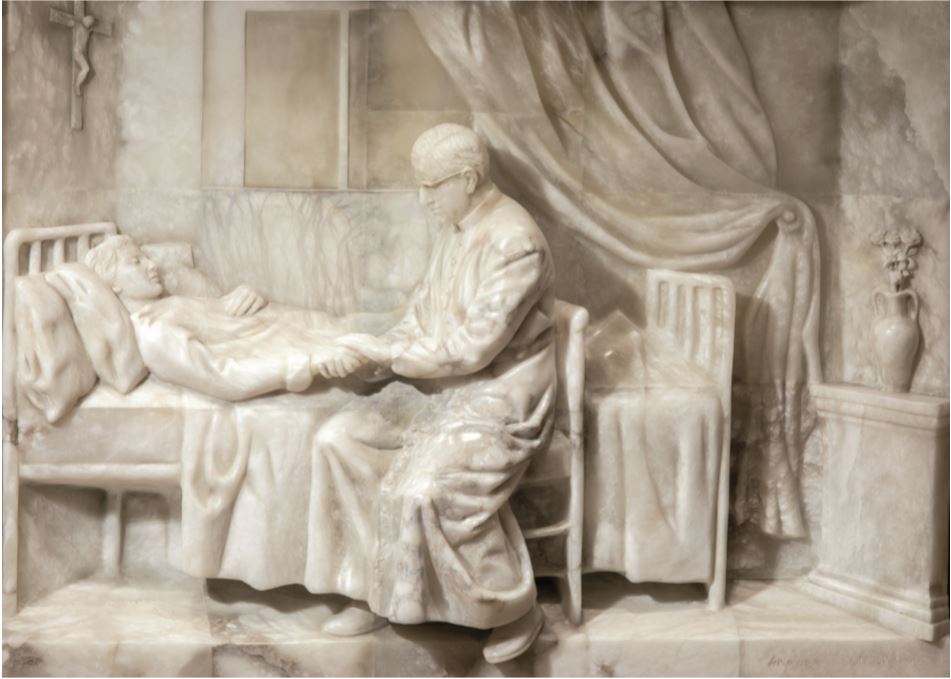This representation of Our Lady of the Incarnation was made in our workshops and presented in the Cathedral of Almeria in November. It is a carving of round bulk worked in linden wood, stewed, gilded and polychromed..
The image represents the Virgin Mary seated on a throne, tenderly embracing the Child. The Child, seated on his left knee, raises his hand in blessing.

THE VIRGIN AND CHILD IN CHRISTIAN ICONOGRAPHY
The representation of the Virgin with the Child Jesus seated or standing on her lap has its origins in the Oriental religions of antiquityfrom which we have images such as that of Isis with her son Horus, and from later references present in medieval christian art that present to the Virgin as "Sedes Sapientiae" or throne of God and the Child on his legs occupying the central position.
As of Gothic period and as naturalism progresses in art, the theme begins to move away from the figuration of Mary as a "throne" to place greater emphasis on the mother-child affection relationshipThe relationship is a close relationship, full of tenderness, which aims to move the hearts of the faithful. From this point on, the secondary role of Mary-throne begins to be lost and the love between Jesus and Mary acquires the leading role.

1. Faience statuette of Isis and Horus, Eton College Myers Collection.
2. Virgin seated with Child. XII century. Cathedral of Navarra
3. White Virgin. XIII Century, Toledo Cathedral.
The Virgin of the Incarnation has a posture far removed from medieval rigidity and symmetry, more heir to naturalistic representation.
In order for the image to be effectively integrated into the whole of the presbytery, Renaissance and early Andalusian and Levantine Baroque sculptures were used as stylistic references, giving more movement to the pose and gesture, as well as to the draping of the drapery and the design of the stews, which reproduce historical fabrics of the time, incorporating Marian iconography. The position, gesture and orientation of the heads were made thinking of the location of the image in the presbytery of the cathedral, so that the virgin and the child would encompass the faithful with their gaze.
DESIGN, MODELING AND CARVING PROCESSES
This project for the Cathedral of Almeria was approached with an initial work of documentation which gave rise to different sketches and test models made of clay.
Once the final model has been chosen, it is subjected to a process of digitalization which consists of scanning the surface of the part, obtaining from it a 3D image. This is one of the technological innovations that our R & D team has incorporated into the workshop, always knowing that this means that does not conclude the work, as the work is not finished. the most important contribution, with the greatest artistic value and which makes the work unique, is always made by the artist.
The three-dimensional image obtained is then sent to a numerical control machine that performs the milling on a block of wood. Subsequently it is the carver who culminates the work by sculpting the details on the volumes of the piece and providing life and movement to the work.
GILDING AND POLYCHROMING PROCESSES, AND STEAMING AND POLISHING TECHNIQUES
Once the carving is finished, it is passed to the polychrome section, where the part is prepared and protected with strips of canvas and a coat of hot rabbit glue that ensures the opening of the pores and a good adhesion of the rigging.
After this process, the carving is ready to receive the different finishes, among them, the water gilding with fine gold and stewing, two outstanding techniques at Talleres de Arte Granda that are nourished by artisan traditions preserved for centuries. Since the gold cannot be applied directly on the wood, the carving first receives several layers of white plaster and black plaster, rabbit glue, bowl... until an optimal base for the gilding is formed. The sheets of 23K gold, are carefully applied on this new base. with a pomazon and a flat brush, two tools used by the gilder in view of the fragility and thinness of the fine gold leaf.
Once the piece has been gilded, the The technique of stewing, which consists of covering all the gold with a layer of tempera paint. Then, with a graphite, either ebony, metal or other hard material, the surface layer of paint is removed by drawing ornamental motifs on the clothing.simulating the brocade of the fabrics and the sensation of movement. The colors chosen for the Virgin's vestments - red, blue and white are not arbitrary; they refer symbolically to the Passion of Christ (red tunic), to the concepts of truth and eternity (blue mantle) and to the purity of Mary (white veil).
For the incarnations, the following has been used polishing techniquewhich consists of covering the rigging layers with oil colors and passing a wet lamb's bladder when it is in its optimum state, so that the previously applied warm and cold tones blend with the general tone of the incarnation. The result is a smooth coat with a characteristic sheen.
